#programmer humor programming humor code computer science
Explore tagged Tumblr posts
Text
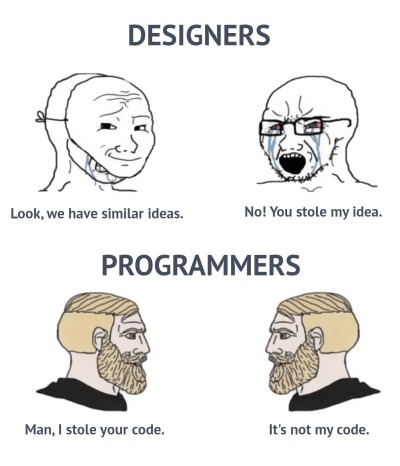
When you find out that your 'original' code is just a copy of a copy of a copy...
#programmer humor#programming#geek#nerd#programmer#computer#python#laptop#c#meme#pc#computer science#java#developer#software developers#full stack web development#code#cs#javascript#c++#software engineer#software development#dev#web development
133 notes
·
View notes
Text
know Python.
A Look into the Python Programming Language
Introduction
Python has become a dominant force in the world of programming. This versatile language is lauded for its readability, extensive libraries, and vast applications. This article delves into the history of Python, explores the reasons why it's a valuable skill to learn, and examines its impact on the world today and tomorrow.
History
Guido van Rossum, a Dutch programmer, designed Python in the late 1980s. His goal was to create a language that was both powerful and easy to learn, emphasizing code readability. Inspired by the humor group Monty Python, he named the language after them. Python's first official release came in 1991, and it has grown steadily in popularity ever since.

Why Learn Python?
There are numerous reasons why Python is a great language to pick up. Here are a few key points:
Readability: Python's syntax is clear and concise, resembling natural language. This makes it easier to learn and maintain code compared to languages with complex syntax.
Versatility: Python is a general-purpose language, meaning it can be used for a wide range of tasks. From web development and data science to machine learning and automation, Python excels in numerous domains.
Extensive Libraries: The Python ecosystem boasts a vast collection of libraries and frameworks. These pre-written tools provide users with functionalities for specific tasks, saving development time.
Large Community: Python has a vibrant and supportive online community. This means there's an abundance of resources and help available for learners and experienced programmers alike.
Python's Global Reach
Python's influence extends far and wide. Here are some examples of how countries around the world are leveraging Python's power:
The United States: Tech giants like Google, Facebook, and Netflix utilize Python for various purposes, including web development, data analysis, and machine learning.
India: Python is a popular choice for software development and data science in India, a country experiencing a major tech boom.
China: China's tech sector is also embracing Python, particularly in areas like artificial intelligence and scientific computing.
The Future of Python
With its adaptability and ease of use, Python is well-positioned for a prominent role in the future of technology. Here are some potential areas where Python might play a key role:
Artificial Intelligence (AI): Python's established libraries like TensorFlow and PyTorch make it a go-to language for developing AI applications.
Data Science and Machine Learning: Python's data manipulation and analysis capabilities will continue to be crucial for these rapidly evolving fields.
Internet of Things (IoT): As more devices become interconnected, Python's potential for scripting and automating tasks within IoT systems will be increasingly valuable.
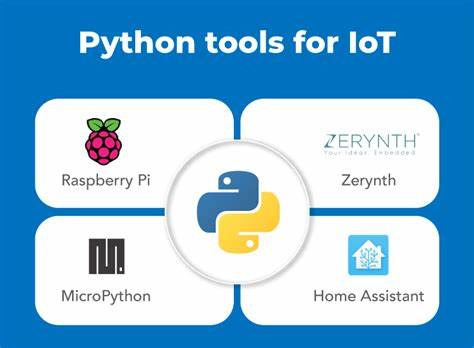
Recent Advancements with Python
Python has been instrumental in the development of several cutting-edge technologies. A few notable examples include:
Self-Driving Cars: Python plays a role in developing the control systems and machine learning algorithms used in self-driving cars.
Facial Recognition Software: Python libraries are used to create and train facial recognition systems.
Natural Language Processing (NLP): Python is a popular choice for developing NLP applications, such as chatbots and machine translation tools.

Working Structure
Source Code:
You write Python code in plain text files with the .py extension. This code is human-readable, resembling natural language for easy understanding and modification.
Compilation (Bytecode):
Unlike some languages that directly translate to machine code, Python utilizes an intermediate step. The Python compiler converts your source code into bytecode, a lower-level representation. Bytecode files typically have the .pyc or .pyo extension.
Python Virtual Machine (PVM):
The bytecode can't be directly executed by your computer's hardware. The Python Virtual Machine (PVM) acts as an interpreter, reading and executing the bytecode instructions. The PVM manages memory allocation and provides an environment for your code to run.
Libraries and Modules:
Python boasts a rich collection of pre-written code called libraries and modules. These modules contain functions, classes, and variables that provide functionalities for various tasks. You can import these modules into your code to leverage their capabilities, saving development time.
Execution:
When you run a Python script, the interpreter reads the bytecode line by line. It executes the instructions, interacting with libraries and modules as needed. The output of your code is then displayed on the console or used within the program itself.
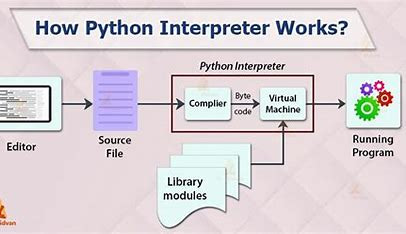
Conclusion
Python's impact on the technological landscape is undeniable. Its readability, vast ecosystem of libraries, and diverse applications make it a language well worth learning. As technology continues to evolve, Python is sure to remain a powerful tool that shapes the future.
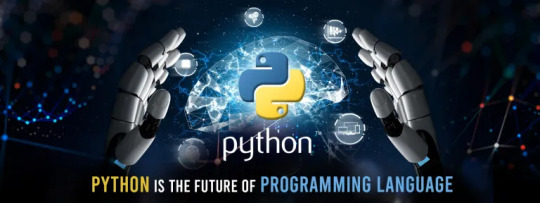
0 notes
Photo
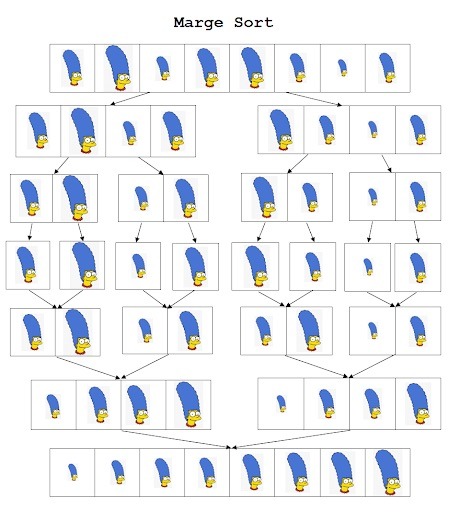
Marge Sort
Getting a computer to sort a list of numbers is surprisingly complicated, and there are a zillion different ways to do it. This means mathematicians and computer scientists think that it's super interesting and spend a lot of time studying, developing, and comparing sorting algorithms. You could spend a whole day just watching YouTube videos of people representing these algorithms in music and dance.
The joke is a play on merge sort, one of the more popular sorting algorithms. At the top of the image you have a bunch of different-sized pictures of Marge Simpson, and at the bottom they're all in order from smallest to largest. The image is a diagram of how merge sort works.
Explaining sort algorithms is a popular job interview question in the tech industry, so I'll go into more detail here.
Imagine a bunch of numbers all standing in a line. We want the smallest number to end up on the left, and the biggest number to end up on the right.
25743986
A computer using merge sort will split those numbers up into pairs.
25 74 39 86
Then, for each pair, it'll check if the smaller of the two numbers is on the left. If it's on the right, the computer will make the numbers switch places.
25 74 39 86 \/ \/ \/ \/
25 47 39 68
Next, the computer will go two pairs at a time to see which pair starts with a smaller number.
25 47 39 68 \__/ \__/
It'll put those smaller numbers in a new group. This is where the merging begins.
5 47 9 68 2 3
Then it'll repeat over what's left of the pairs, comparing the first two numbers in each one.
5 47 9 68 \_/ \_/ 2 3
Then it'll add the smaller numbers on to the new groups.
5 7 9 8 24 36
Lather, rinse, repeat:
5 7 9 8 \__/ \__/ 24 36
7 9 245 368
2457 3689
Now you have two groups of 4 numbers. The computer will compare the first number of each group:
2457 3689 \____/
...and will repeat from there.
457 3689 \___/ 2
457 689 \____/ 23
57 689 \___/ 234
7 689 \__/ 2345
7 89 \___/ 23456
89 \/ 234567
9 2345678
23456789
6 notes
·
View notes
Text
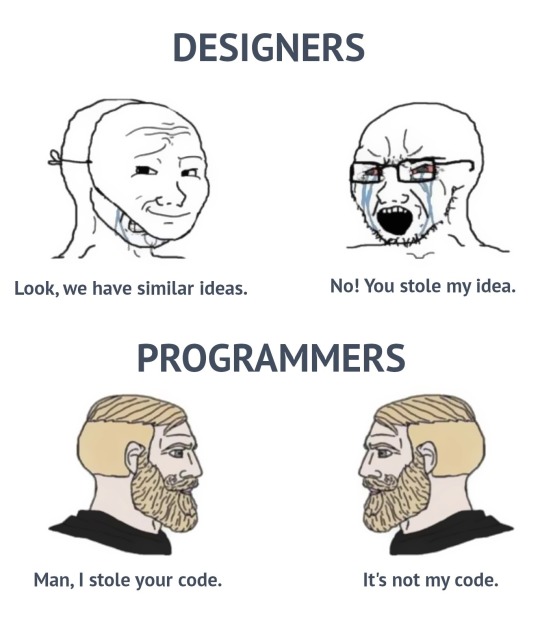
#programmer humor#programming#geek#nerd#programmer#computer#python#laptop#c#meme#pc#computer science#java#developer#software developers#full stack web development#code#cs#javascript#c++#software engineer#software development#dev#web development
1K notes
·
View notes
Text










Love these - LINK TO THREAD
#codeblr#coding#programming#progblr#studyblr#code#comp sci#learn to code#webdev#programmer#computer science#programming memes#programming meme#coding meme#coding memes#programming humor
108 notes
·
View notes
Text
#coding#programming#programmer#developer#codenewbie#webdev#app developers#webdevelopment#codinghumor#funny#humor#lol#lmao#memes#javascript#computer science#machine learning#artificial intelligence#data science
20 notes
·
View notes
Text
Switch statement Java
An expression can be of byte, short, int, long, enum types, String and some wrapper types like Byte, Short, Int, and Long. You can place a variable or an expression in between brackets of switch().
You can create any number of cases in switch statement.
The case value must be literal or constant. The case value type should be a type of expression.
Each case should be unique. If you create duplicate case value, it will throw compile-time error.
Each case has a break statement which is optional. It is used inside the switch to terminate a statement sequence and jumps the control after the switch expression.
If a break statement is not used in any case the execution will continue into the next case until a break statement is reached.
In the switch, we can have an optional default case that must be placed at the end of the switch statement. If none of the cases are true, then this default case will be executed. The default case doesn’t need break statement.
Read more from JavaGoal.com


Read more from JavaGoal.com
#programming#programmer#python#laptop#computer#computer science#stem#software engineering#software#code#coding#programmer humor#geek#nerd
2 notes
·
View notes
Text

I need your help in my writing career. Please read my article via link and give me some suggestions as a reader. https://www.arhamsoft.com/blog/2023/10/23/hire-php-developers-13-convincing-reasons/
#developers#programmer#offshore#programmer humor#programming#web development#app development#it services#software development#framework#codeblr#awesome project#online community#community#coding#progblr#studyblr#studying#computer science#tech#comp sci#medium writing#articles#signal boost
0 notes
Text
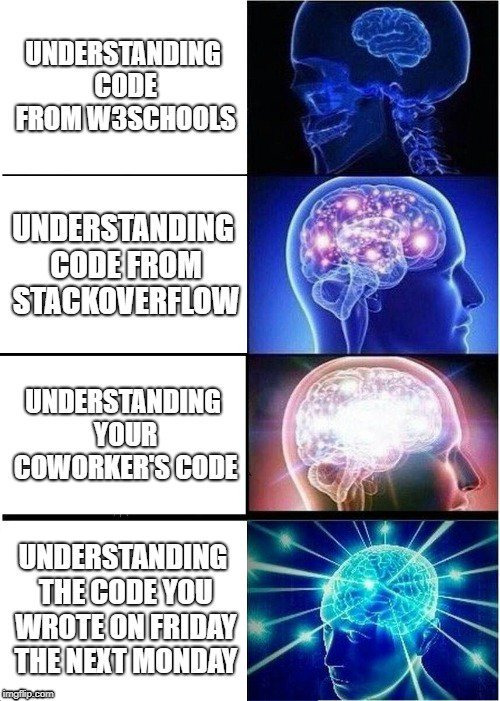
#computer science#programming#software engineering#studyblr#software development#coding#software developer#engineer#software engineer#techblr#programming humor#programmer humor#coding humor
414 notes
·
View notes
Text
A day in the life of a cs student

#comsci#compsci#computer science#studyblr#programming#coding#programmers humor#software engineering#software development
357 notes
·
View notes
Text
5 Projects for Computer Class
Computer class can and should be more than just the basics of typing and the understanding of how to use web applications. Computer class should be fun. Why? Because when your students are engaged, they’re learning. And that’s what it’s all about.
We’re going to go over five fun projects to use in your computer class. Not only are these activities engaging, they’re cross-curricular, and meet Common Core, AP, and Computer Science standards. Better yet? They include strategies to build communication and critical thinking skills.
Projects we’ll go over in this article are:
Create a Filter
Make a Meme
Bestie Greeting Card
Code the News
Climate Clock
Let’s get to it!
Create a Filter
Using the basics of JavaScript, your students will create fun, unique filters for videos that reflect their abilities and personalities. They can use the videos provided by Vidcode, or they can use videos of themselves. Sign up to assign Create a Filter to your class, or visit vidcode.com/project/filters.
Reflection Questions
Who is a programmer?
What is a function?
What is an argument?
Standards Addressed
CCSS.MATH.PRACTICE.MP7 Look for and make use of structure.
NGSS Practice 5 Using mathematics and computational thinking
CSTA 1B-AP-11 Decompose (break down) problems into smaller, manageable subproblems to facilitate the program development process.
CSTA 1B-AP-15 Test and debug (identify and fix errors) a program or algorithm to ensure it runs as intended.
Make a Meme
Memes have changed the way we communicate - often with a sense of humor. This is a project your students will love! Your students will use JavaScript to embellish a video with graphics and text. Sign up to assign Create a Filter to your class, or visit vidcode.com/project/graphics.
Reflection Questions
What is a project?
What is a method?
Standards Addressed
CCSS.MATH.PRACTICE.MP6 Attend to precision.
CSTA 1B-AP-09 Create programs that use variables to store and modify data.
CSTA 1B-AP-11 Decompose (break down) problems into smaller, manageable subproblems to facilitate the program development process.
CSTA 1B-AP-14 Observe intellectual property rights and give appropriate attribution when creating or remixing programs.
CSTA 1B-AP-15 Test and debug (identify and fix errors) a program or algorithm to ensure it runs as intended.
Bestie Greeting Card
Help your students spread the love by creating a greeting card!
This is a special hour of code project. Using JavaScript, your students will create a greeting card while learning about pixels and placing them on an x-y grid, using and writing functions, and changing function values to create different effects. Use Bestie Greeting Card with your class.
Reflection Questions
How would you explain creative coding to a friend?
What did you learn during this hour of code?
Standards Addressed
CSTA 1B-AP-09 Create programs that use variables to store and modify data.
CSTA 1B-AP-10 Create programs that include sequences, events, loops, and conditionals.
CSTA 1B-AP-15 Test and debug (identify and fix errors) a program or algorithm to ensure it runs as intended.
CSTA 1B-IC-21 Use public domain or creative commons media, and refrain from copying or using material created by others without permission.
CSTA 1B-IC-18 Discuss computing technologies that have changed the world, and express how those technologies influence, and are influenced by, cultural practices.
Code the News
In this Hour of Code projects, students follow the provided tutorial that walks them through the basics of JavaScript, functions, and other programming basics.
In this project, we offer extension activities beyond just the hour of code, allowing students to dive deeper into the meanings of conditionals and functions. During the activity, students are encouraged to explain their thinking to their classmates using small-group and whole-group discussion questions. Use Code the News with your class.
Reflection Questions
Does code look like you expected? Is it easier/harder?
What is a function?
What is an argument?
Are you impressed your code is looking more advanced?
Standards Addressed (a handful, because so many are addressed across the curriculum!) Common Core Standards for Mathematical Practice
CCSS.MATH.PRACTICE.MP1 Make sense of problems and persevere in solving them.
CCSS.MATH.PRACTICE.MP2 Reason abstractly and quantitatively.
CCSS.MATH.PRACTICE.MP3 Construct viable arguments and critique the reasoning of others.
Next Generation Science Standards for Engineering Practices
Practice 1 Defining problems
Practice 2 Developing and using models
Practice 3 Planning and carrying out investigations
CSTA
CT.L2-01 - Use the basic steps in algorithmic problem-solving to design solutions (e.g., problem statement and exploration, examination of sample instances, design, implementing a solution, testing, evaluation).
CT.L2-03 - Define an algorithm as a sequence of instructions that can be processed by a computer.
CT.L2-04 - Evaluate ways that different algorithms may be used to solve the same problem.
CT.L2-07 - Represent data in a variety of ways including text, sounds, pictures, and numbers.
Climate Clock
Give your students the chance to use programming to change the world. In this Climate Clock project, students address the climate crisis.
Climate Clocks give a visual representation of just how urgent the climate crisis is. In this project students will create their own climate clocks. Your students will use JavaScript’s Date object to keep track of years, months, days, hours, seconds, and even milliseconds.
Students will also be introduced to modulo, the important math behind keeping the units used in the code straight. Use Climate Clock with your class.
Reflection Questions
What is some other information that you think would be useful in a Climate Clock?
What else do you think is important to keep track of?
How can engaging in work like this make a difference?
Standards Addressed
CSTA 3-5.AP.08 Compare and refine multiple algorithms for the same task and determine which is the most appropriate.
CSTA 6-8.AP.11 Create clearly named variables that store data, and perform operations on their contents.
CSTA 6-8.AP.13 Decompose problems and subproblems into parts to facilitate the design, implementation, and review of programs.
CSTA 6-8.AP.16 Incorporate existing code, media, and libraries into original programs, and give attribution.
Conclusion
Your students are the future of coding and programming. They deserve awesome instructors like you to facilitate learning experiences that are applicable to real life. Thankfully, Vidcode has made this easier for everyone by offering these five fun and engaging coding projects for your students. These five programming projects cover cross-curricular standards, supported by critical thinking discussion prompts. These projects will introduce important coding skills to your students as they get a taste for how their coding abilities can impact the world around them.
4 notes
·
View notes
Photo
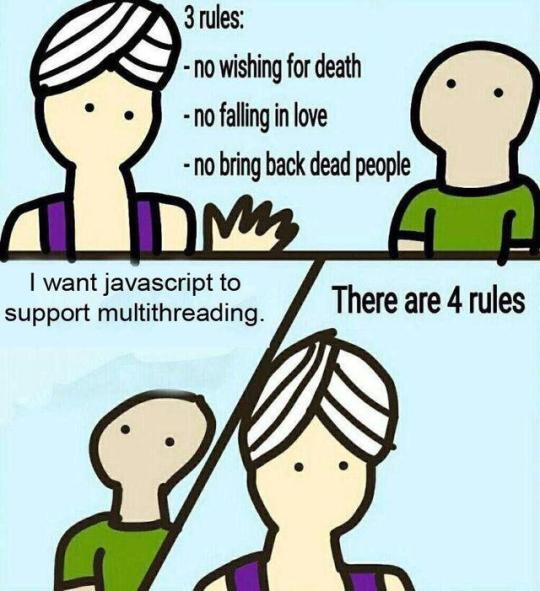
3 wishes, 3 rules... OK, 4 rules.
A computer program is a big series of instructions. A thread is an instance of the computer following instructions in order.
Shouldn't a computer always follow instructions in order?
Let's say you wrote a program to make a peanut butter and jelly sandwich:
Open bag of bread
Remove two slices of bread from bag
Apply peanut butter to one slice
Apply jelly to other slice
Put slices together
Most of those steps have to go in that order. You can't "remove two slices of bread from the bag" unless you have an open bag of bread in front of you.
But it doesn't matter in what order you apply the peanut butter and you apply the jelly. If you're really good with your hands and good at multitasking, you could do both at the same time and eat your sandwich sooner.
This would be an example of a single thread (following instructions one-at-a-time) splitting into two threads (following two instructions at the same time), then going back to one thread.
Multithreading is the ability of a computer to follow multiple instructions at the same time.
The joke is many programming languages support multithreading, but as nice as it might be, JavaScript doesn't. This is mostly because JavaScript wasn't built that way, and trying to add it in now would break a lot of things. It would be great if the US started using the Metric System, too, but if you replaced all the nation's speed limit signs, measuring cups, and rulers overnight, the next day would be a hot mess.
Plus, multithreading has its downsides. It's hard to keep one thread from starting or stopping before the other is ready. You know that you shouldn't put the slices of bread together until both have their toppings, but a robot wouldn't know that, and might finish the jelly slice first and try to stick it onto the peanut butter slice before it's ready, causing the bread to get all mangled and jelly to go everywhere. This is an example of a race condition ('race' as in 'speed', not as in 'demographics').
Multithreading also uses more computing power. I can make a PB&J pretty well, but I don't have the mental capacity to put peanut butter on one slice and jelly on another at the same time.
8 notes
·
View notes
Text

#programmer humor#programming#geek#nerd#programmer#computer#python#laptop#c#meme#pc#computer science#java#developer#software developers#full stack web development#code#cs#javascript#c++#dev#software engineer#software development#software#website#apps#errors#the office#the office meme
558 notes
·
View notes
Photo

Nitrogen reference
name: nitrogen nicknames: nitro, gen age: around 28 human terms gender: femme designation number: N-3554-N faction: decepticon alt. mode: finnish f-18 place of landing: finland family: Boron (brother) stats: strength: 4 intelligance: 9 speed: 7 endurance: 6 rank: 7 courage: 7 firepower/fireblast: 5 skill: 9 personality: a tech wiz and wicked fast in reaction time, nitrogen is your femme when it comes to taking out a target. she can snipe and work large machine guns. she always isolates herself when it's actually needed but wouldn't mind a little chat. in her spare time, she's been trying to beat soundwave's best score in strategy games and other video games. she also knows how to fix computers. she wishes to some day design and create a program that can some how change the world. she exels in programming and hacking so watch out if you mess with her. her knowledge of working at fast paces places her into the top decepticons with fastest reaction time. her one goal in combat is to get a faster reation time than megatron. she'll get there somehow... someday. she's also wicked smart at programming. however, she's quiet. unlike her brother, who's a chatterbox, nitrogen likes to keep things simple and to the point. although, she has a temper when her work is messed up. bio: born in Iacon, nitrogen was the daughter of a pair of engineers. she grew up in a loving enviroment with her brother, Boron. she grew very knoledgeable and did well in school in mathmatics and programming. even when her family moved to Kaon. Nitrogen kept her studies a to priority and even made it to the Kaon academy of sciences, where she studied programming and engineering whie her brother participated in chemistry. they graduated right when the war was going to start in Kaon with the rust epidemic. having no other choice but to join the decepticons after her parents died from the epidemic, she and her brother followed megtron's lead. with a knowledge of technology, she secretly had created prototype hacking weapons but they were lost when she and her brother got fled to earth and crashed into finland after a tracking system and the main engine failed. both Boron and Nitrogen began to no longer speak cybertronian as they started blending in to wait for help (their communications systems were beyond recovery from the crash) and started speaking finnish. eventually, boron accidentally revealed himself and he went missing. considering teh worse, nitrogen made fixing her ship's communications a priority, just enough to send a distress signal. she got it working enough to send a signal to the nemesis and was eventally brought on board. once abord the nemesis, she met Eureka and Thrust fault who she started becoming friends with. strangely, megatron has files on her parents but she isn't allowed to view them. her new goal is to hack the nemesis computer to figure out why, since she sees this as oddly strange. fun facts: - she was “born” on the 1st of March - she's very use to cold temperatures - she wears "glasses". she got the poor vision genes that run in the family. - Her gimmick is throwing a rubber duck when she realizes her mistakes. This is from rubber duck debugging where programmers explain the code to a rubber duck to find out what happened. Because she is a programmer, she uses this and there have been many a time that cons on the nemesis that have reported her throwing rubber ducks while yelling what she did wrong. This has extended to not just when she's programming. Whenever she realizes she's using something wrong or pronounced something wrong she'll get a rubber duck from her subspace and throw it. When there is no rubber duck in the room, she'll ask someone to sit still and listen so she can explain the code she's writing before realizing something and going to find a rubber duck and throw it out of anger. if it were in a show/movie/comic it would be a humor device but still shows that she's not the most perfect programmer ever and shows her background. - the rubber duck she throws is named "Chuck"
3 notes
·
View notes
Text
John Titor A Time Traveler's Tale by John Titor, December 1, 2003, Instantpublisher.com edition, Paperback in English.
John Titor is the name used on several during 2000 and 2001 by a poster claiming to be a from the year 2036. In these posts Titor made numerous predictions (a number of them vague, some quite specific ) about events in the near future, starting with events in 2004. However, as of 2013, these events have not taken place; he described a drastically changed future in which the had broken into five smaller regions, the environment and infrastructure had been devastated by a nuclear attack, and most other world powers had been destroyed. To date, the story has been retold on numerous web sites, in a book, in a play, and the Japanese /.
Titor has also been discussed occasionally on the radio show. Contents History The first posts appeared on the Time Travel Institute forums on November 2, 2000, under the name TimeTravel0. At the time the posts had nothing to do with future events and the name 'John Titor' was not being used. Instead, the posts discussed time travel in general, the first one being the 'six parts' description of what a time machine would need to have to work (see below) and responses to questions about how such a machine would work. Early messages tended to be short. The name 'John Titor' was not introduced until January 2001, when TimeTravel0 began posting at the BBS Forums (which required a name or for every account).
The Titor posts ended in late March 2001. , a number of the threads became corrupted; but Titor's posts had been saved on subscribers' hard drives and were copied to Anomalies.net, along with new discussions of the science behind Titor's time travelling as well as his predictions. Around 2003, various websites reproduced Titor's posts, re-arranging them into narratives.
Not all refer to the original dates posted. Outline In his online postings, Titor claimed to be an American soldier from 2036, based in in, who was assigned to a governmental time-travel project. Purportedly, Titor had been sent back to 1975 to retrieve an computer which he said was needed to ' various legacy computer programs in 2036; a reference to the. The 5100 runs the and programming languages. Titor had been selected for this mission specifically, given that his paternal grandfather was directly involved with the assembly and programming of the 5100. Titor claimed to be on a stopover in the year 2000 for 'personal reasons'; i.e., to collect pictures lost in the (future) civil war and to visit his family, of whom he spoke often.
Titor also said he had been, for a few months, trying to alert anyone that would listen about the threat of spread through beef products and about the possibility of civil war within the United States. When questioned about them by an online subscriber, Titor also expressed an interest in mysteries such as (which remained unexplained in his time).
Titor suggested that UFOs and might be travelers from much further into the future than his own time, with superior time machines. Time machine Titor described the time machine on several occasions. In an early post, he described it as a 'stationary mass, temporal displacement unit powered by two top-spin, dual positive singularities', producing a 'standard off-set Tipler sinusoid'. The earliest post was more explicit, saying it contained the following:. Two magnetic housing units for the dual micro singularities.
An electron injection to alter mass and gravity micro. A cooling and venting system. Gravity sensors, or a variable gravity lock. Four main clocks.
Three main computer units According to the posts, the device was installed in the rear of a 1967 convertible and later moved to a 1987 truck having four-wheel drive. Titor also shared several scans of the manual of a 'C204 Time Displacement Unit' with diagrams and schematics. He also shared some photographs of the device installed in the car.
Titor further claimed that the 'Everett–Wheeler model of quantum physics' was correct. This model, better known as the, posits that every possible outcome of a quantum decision actually occurs in a separate 'universe'. Titor stated that this was the reason the would not occur; following the logic of the argument, Titor would be killing a different John Titor's grandfather in a timeline other than his own.The grandfather paradox is impossible. In fact, all paradox is impossible. The Everett–Wheeler–Graham or is correct. All possible, events, possibilities, and outcomes are real, eventual, and occurring. The chances of everything happening someplace at sometime in the superverse is 100%.
Predictions Although invoking the, whereby events from his own timeline may differ from our own, Titor also expressed assurance that the differences were minimal. As such, his descriptions have been interpreted as predictions and compared with historical events since 2001. The most immediate of Titor's predictions was of an in the United States having to do with 'order and rights'. He described it as beginning in 2004, with surrounding the. This civil conflict that he characterizes as 'having a type event every month that steadily gets worse' will be 'pretty much at everyone's doorstep' and erupts by 2008. Titor claimed that as a 13-year old in 2011, he fought with the Fighting Diamondbacks, a shotgun infantry unit of Florida, for at least four years.
However, in other posts he describes himself as hiding from the war. As a result of the war, the United States splits into five regions based on various factors and differing military objectives. This civil war, according to Titor, will end in 2015 with a brief but intense: In 2015, launches a nuclear strike against the major cities in the United States (which is the 'other side' of the civil war from my perspective),.
The United States counter attacks. The US cities are destroyed along with the AFE (American Federal Empire).thus we (in the country) won. The and China were also destroyed. Titor refers to the exchange as N Day.
And are specifically mentioned as being hit. After the war, is the nation's new capital city. Titor is vague as to the exact motivations and causes for World War III. At one point, he characterized the hostilities as being led by 'border clashes and overpopulation', but also points to the present conflict between and as not a causation, but rather a milestone that precedes a World War III.
Criticism Predictive failures The posts were met with skepticism when they were being posted, but it was impossible to prove beforehand that the predicted events would not happen. Because Titor claimed the many-worlds interpretation of quantum physics was correct, effectively meaning that his travel was from a and that things could occur differently than he had predicted, the details he presented were. One of Titor's earliest assertions was that would discover the basis for time travel sometime around 2001, with the creation of miniature black holes about half a year after his departure. This did not occur. An article occurring generally around the time he had predicted about miniature being created by CERN (a recurring theme, also ascribed to and at various times ) was taken by some to be evidence of this claim; but these events did not occur either. Civil war was not even remotely close to breaking out after the 2004 presidential election, with no further conflict in 2008 and 2012 in the way Titor described, although Stephen Hawking mentioned mini black holes hoping to be discovered by 'A miniature black hole of the mass of a mountain could generate enough power to supply the world’s energy needs. However, the energy would be difficult to harness as the power could not be maintained in a power station.
It would drop through the floor and end up at the center of the Earth.' , 'Scientists have searched for miniature black holes but to no avail.
Hawking said this is a pity as he would have garnered a. However, if a black hole is found through the Large Hadron Collider at (the world’s largest and highest-energy particle accelerator), he interjected humorously, he will get a Nobel Prize after all.'
A particularly obvious example involves the Olympics, whereof Titor claimed: 'As a result of the many conflicts, no, there were no official Olympics after 2004.' The politically uneventful staging of the, the, the, and the refute this claim. Problems with the technology In the context of the demonstration image provided by John Titor, the 's beam being 'bent' reveals the obvious inconsistency of objects near the beam not appearing to be bent as well. The framing of the window visible in the background, for instance, should appear distorted in proximity to a large gravity, but it does not.
Some have speculated the 'beam' is an. Titor claimed that he was sent back to obtain an because it could translate several types of computer code. According to IBM engineer Bob Dubke, Titor's statements regarding the IBM 5100's little-known ability to and debug mainframe systems were correct. Supporters state that this information was not publicly available in 2000 or 2001 when Titor made his declaration, and Titor himself stated that this feature was 'discovered' as late as 2036 when, as the underlying source behind all computer operating systems still running local infrastructures and other computational tasks, was only due to integer limitations. However, this emulation capability was widely known in the industry and commented on in depth in numerous publications dealing with both the 5100 and programmable microcode in general.
to this fact were also available on the Internet as early as 1999 and therefore predated Titor's postings. This is a fairly obscure bit of trivia, however, which suggests that whoever was making the posts either was familiar with the machine specifically or else had at least a general interest in. Problems with the story Numerous commentators have pointed out the extensive similarities between the Titor story and 's classic post-apocalyptic science fiction novel. Among other similarities, Alas, Babylon takes place in a small river-side town in Florida just before and after a nuclear war and describes the struggle to survive as a family in the aftermath. In the book, the protagonist lives in the mythical town of 'Fort Repose', while Titor claimed to live in the 'Fort', formerly the (UF).
The internal consistency of Titor's story has been questioned: for instance, in some posts he claims that money is widely used and people still have, despite his statement that centralized banking no longer exists (this is either an inconsistency or implies the rise of ). In another posting he speculated that today's would be usable in his time, but that this would be after the reorganization of the federal government according to his own history, making the currency worthless. Other problems with the story include inconsistencies in Titor's comments. His first appearance appears to have been not in 2000, but in the summer of 1998 through two faxes to Art Bell's radio program. When he began posting the online story, (January 1, 2000) had come and gone without any real problems. Yet in the 1998 faxes to Art Bell he said, 'Y2K is a disaster.
Many people freeze to death trying to get to warmer weather. Tries to keep power by instituting marshall sic law.' In the online story, Titor stated that a part of his mission was to prevent the coming world war by changing history. Yet during an IRC chat in October 2000, a month before he began posting, Titor was asked if the future could be changed from his predictions, and answered 'It's too late. I just wish things didn't have to happen the way they will.' This stated mission also contradicts his other posts explaining that the multiverse theory is correct (see above), which would make changing history pointless in the context of his own timeline.
Inquiry on the story An Italian TV program ( Voyager – Ai confini della conoscenza) aired an investigation of the John Titor story on May 19, 2008. Mike Lynch, the private detective hired to investigate, found that there were no registry traces, even far in the past, of any John Titor or Titor family. In addition, he discovered that there was a company that was called the John Titor Foundation. The John Titor Foundation is a for-profit Florida LLC that was formed September 16, 2003.
It had no office, and it only had a rented post box with the address PMB 237, 7862 W IRLO BRONSON HWY, KISSIMMEE FL 34747; no tapes, recordings, or evidence of Titor were found; and only Larry Haber, the CEO of the John Titor Foundation and an entertainment lawyer in Celebration, Florida, confirmed his existence. Lynch's conclusion is that John Titor may be John Rick Haber, a computer expert who is Larry Haber's brother. In popular culture. In 2003, the John Titor Foundation published a book, John Titor: A Time Traveler's Tale , discussing his claims; the book is now out of print. In 2004, a play based on the John Titor story, was staged in the United States.
2 notes
·
View notes
